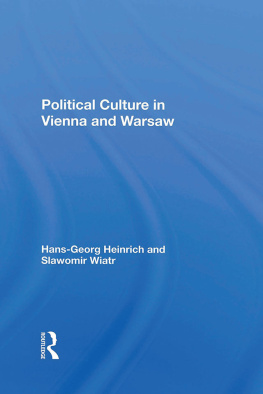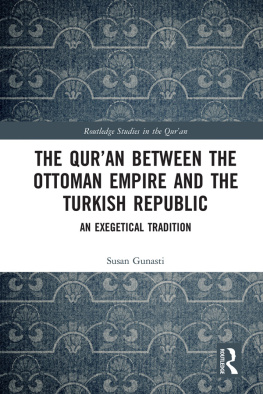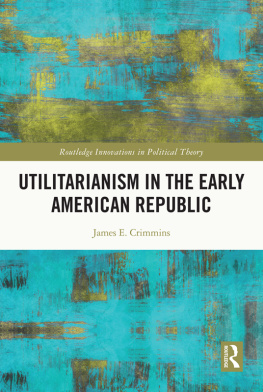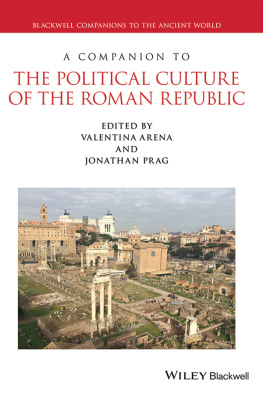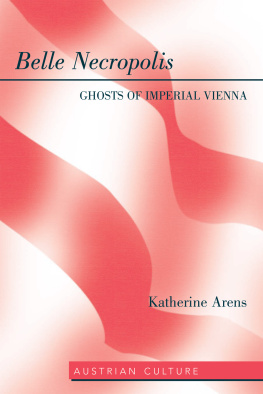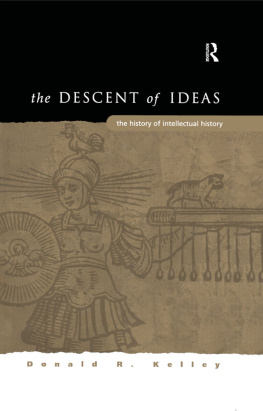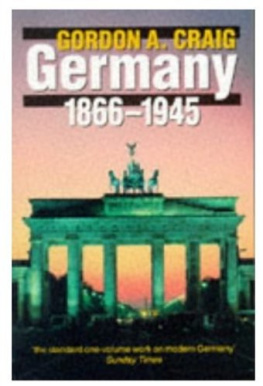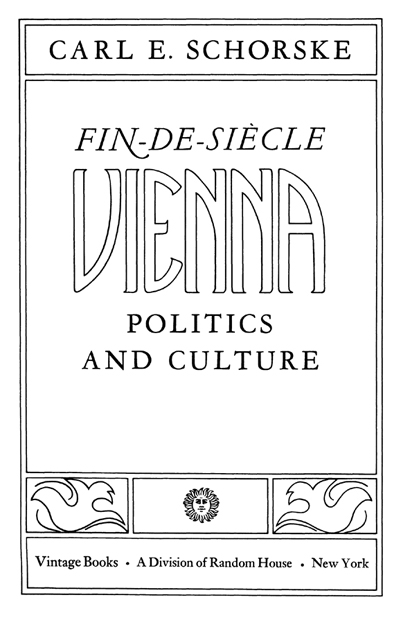ALSO BY CARL E. SCHORSKE
German Social Democracy, 19051917
The Problem of Germany (with Hoyt Price)
VINTAGE BOOKS EDITION , January 1981
Copyright1961, 1967, 1973, 1979 by Carl E. Schorske All rights reserved under International and Pan-American Copyright Conventions. Published in the United States by Random House, Inc., New York, and in Canada by Random House of Canada Limited, Toronto. Originally published by Alfred A. Knopf, Inc., New York, in January 1980.
The following originally appeared as articles in the
American Historical Review:
Politics and Patricide in Freuds Interpretation of Dreams, Vol. 78 (April 1973), pp. 32847.
The Transformation of the Garden: Ideal and Society in Austrian Literature, Vol. 72 (July 1967), pp. 1283320.
Politics and the Psyche in Fin-de-sicle Vienna: Schnitzler and Hofmannsthal, Vol. 68 (July 1961), pp. 93046.
Grateful acknowledgment is made to the following for permission to reprint from previously published material:
University of Chicago Press: Politics in a New Key: An Austrian Triptych, The Journal of Modern History, Vol. 39 (December 1967), pp. 343386. Copyright1967 by the University of Chicago.
Owing to limitations of space, all other acknowledgments for permission to reprint previously published material, and all acknowledgments for permission to reproduce illustrations, will be found following the index.
Library of Congress Cataloging in Publication Data
Schorske, Carl E Fin-de-sicle Vienna.
1. ViennaIntellectual lifeAddresses, essays, lectures.
2. AustriaPolitics and government18671918
Addresses, essays, lectures.
I. Title.
DB851.S42 1981 943.61304 8011043
eISBN: 978-0-307-81451-7
v3.1
For Liz
Contents
Illustrations
Figure
Vienna before redevelopment (map)
Leaflet announcing Ringstrasse development
Ringstrasse with Parliament, Rathaus, University, and Burgtheater
Rathaus (F. Schmidt)
Hofburgtheater (G. Semper and C. Hasenauer)
University (H. Ferstel)
Reichsrat (Parliament)
Athena fountain
Krntner Ring
Reichsratsstrasse
Stairwell in Krntner Ring No. 14
Vestibule in Reichsratsstrasse No. 7
Gruppenzinshaus
Floor plan of the Gruppenzinshaus
Schwarzenbergplatz
Concordiaplatz
Herrengasse
Oesterreichische Lnderbank (O. Wagner), street facade
Oesterreichische Lnderbank, rear court
Oesterreichische Lnderbank, stairwell
Unter-Dbling Station (O. Wagner)
Nussdorf Dam: aesthetic engineering (O. Wagner)
Apartment houses (O. Wagner), Linke Wienzeile and Kstlergasse
Postal Savings Office (O. Wagner)
Neustiftgasse No. 40 (O. Wagner)
Modular City District (O. Wagner)
Drawing of an Air Center (O. Wagner)
Modular Plan for the Expansible City (O. Wagner)
Outer Burgplatz (G. Semper)
Museum City Project: Artibus (O. Wagner)
Gallery for Artworks of Our Age (O. Wagner)
House of Art, MCM-MM (O. Wagner)
Grand Stairway of the Burgtheater
Shakespeares Theater, ceiling painting (G. Klimt)
Auditorium of the Old Burgtheater (G. Klimt)
Athena, spandrel (G. Klimt)
Poster for the First Secession Exhibition (G. Klimt)
Nuda Veritas (G. Klimt)
House of the Secession (J. Olbrich)
Schubert at the Piano (G. Klimt)
Music (G. Klimt)
Untitled (Sensuous Girl) (G. Klimt)
Fish Blood (G. Klimt)
Salome (G. Klimt)
Philosophy, ceiling painting (G. Klimt)
Medicine, ceiling painting (G. Klimt)
Jurisprudence, composition study (G. Klimt)
Jurisprudence, ceiling painting (G. Klimt)
Goldfish (G. Klimt)
Beethoven (M. Klinger)
Secession Interior for the Beethoven Exhibit (J. Hoffmann)
Beethoven frieze, Panel I (G. Klimt)
Beethoven frieze, Panel II (G. Klimt)
Beethoven frieze, detail of Panel III (G. Klimt)
Beethoven frieze, detail of Panel III (G. Klimt)
Kunstschau Pavilion (J. Hoffmann)
Oscar Wildes Birthday of the Infanta (Kunstschau Garden Theater)
Illustration from The Dreaming Boys (O. Kokoschka)
Illustration from The Dreaming Boys (O. Kokoschka)
Pen-and-brush drawing for Murderer, Hope of Women (O. Kokoschka)
Untitled (E. Sthr)
. The Book of the Hanging Gardens, Song I (A. Schoenberg)
Poster (self-portrait) (O. Kokoschka)
:
Color Plate
Pallas Athena (G. Klimt)
Watersnakes II (G. Klimt)
Judith and Holofernes (G. Klimt)
Portrait of Margaret Stonborough-Wittgenstein (G. Klimt)
Portrait of Fritza Riedler (G. Klimt)
Portrait of Adele Bloch-Bauer (G. Klimt)
Danae (G. Klimt)
The Kiss (G. Klimt)
Death and Life (G. Klimt)
Insert following :
Color Plate
The Red Stare (A. Schoenberg)
Kunstschau poster (O. Kokoschka)
Lithograph and text from The Dreaming Boys (O. Kokoschka)
Poster for Murderer, Hope of Women (Piet) (O. Kokoschka)
Portrait of Herwarth Walden (O. Kokoschka)
Portrait of Hans Tietze and Erica Tietze-Conrat (O. Kokoschka)
The Tempest (O. Kokoschka)
Portrait of the architect Adolf Loos (O. Kokoschka)
Acknowledgments
E VEN THE MOST individual scholarly work, viewed in terms of the economic, intellectual, and psychological support necessary to its accomplishment, turns out to be a social enterprise. In the case of a work so slow to grow as mine, whose production resembled less the determined making of a book than the shaping of a record of continuing exploration, one becomes especially conscious of the magnitude of personal help and institutional sustenance received along the way.
A fellowship from the John Simon Guggenheim Foundation made possible a valuable year of initial reading and research in London. My three universitiesWesleyan, California at Berkeley, and Princetonprovided leave time and financial support for the work. Such release from teaching duties enabled me to accept the hospitality of the Center for Advanced Study in the Behavioral Sciences (Stanford), the Institute for Advanced Study (Princeton), and Wesleyans Center for the Humanities. The American Council of Learned Societies also supported my writing at the Wesleyan Center.
Among the many scholars whom I wish to thank, Felix Gilbert must be among the first. He helped me early to define my field of inquiry and later guided me around many a pitfall with that gently emendatory spirit of erudite criticism which has made him the prime post-graduate educator of so many historians of my generation and the next. Professor Gilberts sister, the late Mary Gilbert of Kings College, London, introduced me to the poetry of Hofmannsthal and to his social circle, while Leopold Ettlinger and Ernst Gombrich at the Warburg Institute library gave me some preliminary guidance into the swampy world of Austrian


